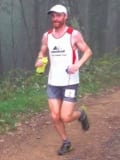On my recent visit to Spain to run the Transvulcania 50-mile race, I heard a lot of theories as to why trail races are so different in Europe as compared to the U.S. Specifically, why there are so many trail races in Europe that draw several thousand local fans while virtually none in the States do. This is a topic I’ve talked about on my personal blog in the past, but not until my recent travels abroad did I have the chance to talk about this with so many knowledgeable and experienced runners, race organizers, and race fans from around the world.
To my knowledge, Alaska’s Mount Marathon is the only trail race in the United States (if you actually consider Alaska to be a part of the U.S.) that draws several thousand spectators from the local communities on race day. I’ve heard that Leadville also draws a decent amount of local spectators (maybe someone who has been there on race day can weigh in with a guesstimate on that). Certainly, Mount Marathon’s volume of spectators is aided by the fact that it is held on the 4th of July, and many people are there simply for the Independence Day celebration. There is more at play than just good timing, though, the Mount Marathon race has become the most anticipated and celebrated part of Seward’s 4th of July festivities. At this point, it’s not as much a case of the race benefiting from everyone who is in town for the party, but the party benefiting from everyone who is in town to watch the race. I have not yet been there on race day, but by most accounts there are typically 20,000 spectators!
The most common rhetoric I hear when people talk about why these types of races aren’t the norm in the States, is that there is a fundamental cultural difference between the U.S. and Europe when it comes to individual sports, and that Americans just aren’t interested in attending this kind of thing unless they personally know someone who is competing. There are two things which come to mind right away that disprove this theory: car racing and Mount Marathon.
I think it is true that mountain trail running is much more a part of mountain communities in Europe than it is in the U.S., but I do not believe that this is because Americans don’t care about this kind of thing, and never will. Mount Marathon is a perfect example that “if you build it they will come.” That is, if you bring a race to the people, people will come to the race. For many reasons, the approach in the States has long been to keep trail races remote and thus removed from potential spectators. Very few trail races seem to advertise on the local level, and, more often than not, it seems like races that do start, finish, or pass through population centers try to schedule their events to occur when not much of anything else is going on locally. If, on the other hand, you want people to come out and support your event it makes perfect sense to time a race to start/finish in the middle of the afternoon, in the middle of town, on the 4th of July – as Mount Marathon does.
I would never want for all races to become large spectator events, and I don’t think this is anything any of us need to be worried about. But as an American trail runner who has now competed in a few races in Europe, it’s hard not to wish for at least a handful of these types of races here in the U.S. It’s not something that can or will just happen overnight, but I find it odd and surprising that few (if any) trail races in the States are making a conscious effort to lay the groundwork for their race to become highly supported and attended by local communities. I think trail running is an exciting and inspirational sport that would appeal to the masses if more events were structured and organized in a way that incorporates and celebrates the local population. I think I may still be a couple years away from having the time/desire/energy to tackle organizing a race myself, but, if I do, my top priority will be to create a great course, and my second priority will be to create it in a way so that the race has an opportunity to become an exciting part of the community that it takes place in.
